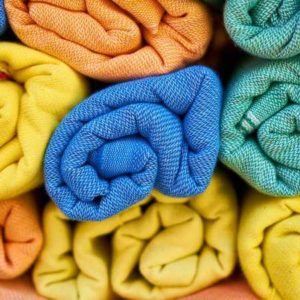Cotton has been used in clothing and textiles for thousands of years. Even though synthetics have surpassed cotton in the global fiber market, cotton remains the second most popular apparel fiber, accounting for 24% of global fiber production in 2020. It is also an essential non-food crop in the world. Growing, transporting, and processing cotton and other ancillary services employ approximately 350 million people, the majority of whom live in low-income countries.
Climate change pressure has compelled major global fashion brands to sign the 2025 Sustainable Cotton Pact. According to the document, these companies have pledged to use only sustainable cotton in their products by 2025. Discover how to identify the three types of cotton growing practices.
Cotton Production and its Impact
Cotton is derived naturally from the cotton plant, making it a renewable and biodegradable material. However, conventional cotton production is estimated to use 16% of the world’s insecticides and 6% of the world’s pesticides each year; staggering figures for just one crop. These chemicals are frequently highly toxic, contaminating groundwater and emitting nitrous oxide, a greenhouse gas that contributes significantly to climate change. Chemical-induced soil degradation frequently results in farmers facing declining yields and being forced into poverty. As if that weren’t enough, the pesticides and fertilizers used to grow cotton can cause serious illnesses or even death among cotton farmers – and they’re also toxic to your skin.
Cotton is also a very thirsty crop, requiring approximately 2,700 liters of water to produce enough fiber for one T-shirt. To put that into perspective, it takes the average person approximately 900 days to consume this amount of water.
Climate change pressure has compelled major global fashion brands to sign the 2025 Sustainable Cotton Pact. According to the document, these companies have pledged to use only sustainable cotton in their products by 2025.
Conventional Cotton
Conventional cotton productivity is dependent on a lot of water, high doses of fertilizer, and pesticides to control insects, pests, weeds, and chemical additives that regulate growth.
According to the Higg Materials Sustainability Index, it is one of the least sustainable natural materials available, ranking just below leather and silk. Conventional cotton also accounts for more than a quarter of all pesticides used in agriculture worldwide. These pesticides wreak havoc on the environment by entering the water through runoff. The water is absorbed by plants and consumed by wildlife, posing a threat to biodiversity and the natural environment.
Pesticides are also harmful to humans, both those who contact contaminated water and those who work directly with the substance. It’s a condition known as occupational pesticide exposure, and it’s been linked to:
- Cancers of various types
- Reproductivity issues
- Birth flaws
- Parkinson’s disease (PD)
- Alzheimer
Organic Cotton
Organic cotton is grown without synthetic agricultural chemicals such as fertilizers or pesticides and with cottonseed stock that is not genetically modified. Compared to conventionally grown cotton, the main advantages of organic cotton are improved soil health, higher water quality and biodiversity, and significantly less resource depletion. Farmers will also benefit from improved health outcomes and higher economic returns if they sell at the organic price.
A national certification body where the cotton is grown certifies the majority of organic cotton as meeting an organic agricultural standard. Organic standards vary by country, but they all prohibit the use of genetically modified cotton seeds, pesticides, and synthetic fertilizers; they also require an independent third-party assessment to ensure that standards are met.
In 2019/20, organic cotton accounted for approximately 0.95 percent of the total cotton harvest. Organic cotton farming is estimated to employ over 229,000 farmers. The largest organic cotton producers are India (50 percent), China (12 percent), Kyrgyzstan (12 percent), Turkey (10 percent), Tanzania (5 percent), Tajikistan (4 percent), and the United States (3 percent), which account for 95 percent of global organic cotton production.
Better Cotton Initiative (BCI)
BCI isn’t a cotton variety. It’s a method of cultivation that enables large-scale production. The BCI is a long-term multi-stakeholder initiative that develops and promotes good farm practices that allow more cotton to be grown while using less water and chemicals and protecting both working conditions and biodiversity.
According to the system, cotton farming must meet specific environmental and social requirements. The BCI is not a labeling system, and it does not offer Fairtrade or organic cotton. It is a multi-stakeholder initiative involving NGOs such as the World Wildlife Fund, clothing companies, cotton producer groups, and trade and industry associations. Its goal is to make all cotton more environmentally friendly.
The BCI aims to improve farmers’ outcomes by educating them about water and pesticide use and promoting soil and biodiversity conservation. It is based on six principles.
- Minimizing their use of harmful pesticides
- Using water efficiently caring for the health of the soil
- Conserving natural habitats and biodiversity
- Preserving and caring for the health of the fiber
- Promoting decent work
These principles significantly reduce the environmental impact of cotton production. The standard can be used on farms of any size and works in conjunction with other sustainable cotton standards. The BCI assists farmers in helping them adhere to these principles. It also includes assistance in reducing the use of hazardous chemicals and respecting workers’ rights. Cotton farmers are being trained to use water more efficiently and to care for natural habitats as part of this assistance.
Which Cotton is the Most Environmentally Friendly?
Conventional cotton is not as sustainable as many people believe, and while organic cotton is far less harmful, it may not be the best solution for the fashion industry either. Furthermore, consider that both conventionally and organically grown cotton can be processed with toxic chemicals (cleaning, dying, etc.). When purchasing organic cotton, look for third-party certifications such as GOTS (= Global Organic Textile Standard), which ensures that a garment has been processed following both environmental and social standards – from seed to finished product.
It’s important to remember that even if all the cotton in the world were produced organically, it would still cause some harm to our planet unless we drastically reduce our consumption. As a consumer seeking to make more sustainable decisions, it is best to purchase certified organic cotton and take a slower approach to fashion – by making fewer and more conscious purchases, caring for your clothes, and encouraging others to do the same.
Sources and further information on the topic:
- https://www.soilassociation.org/media/6491/cool-cotton-organic-cotton-and-climate-change-2015.pdf
- http://textileexchange.org/wp-content/uploads/2017/06/Textile-Exchange_Quick-Guide-To-Organic-Cotton_2017.pdf
- https://www.commonobjective.co/article/cotton-and-sustainable-cotton-key-world-commodity
- https://sustainability.c-and-a.com/uk/en/sustainability-report/2018/sustainable-products/sustainable-materials/more-sustainable-cotton/better-cotton-initiative/
- https://www.global-standard.org/







